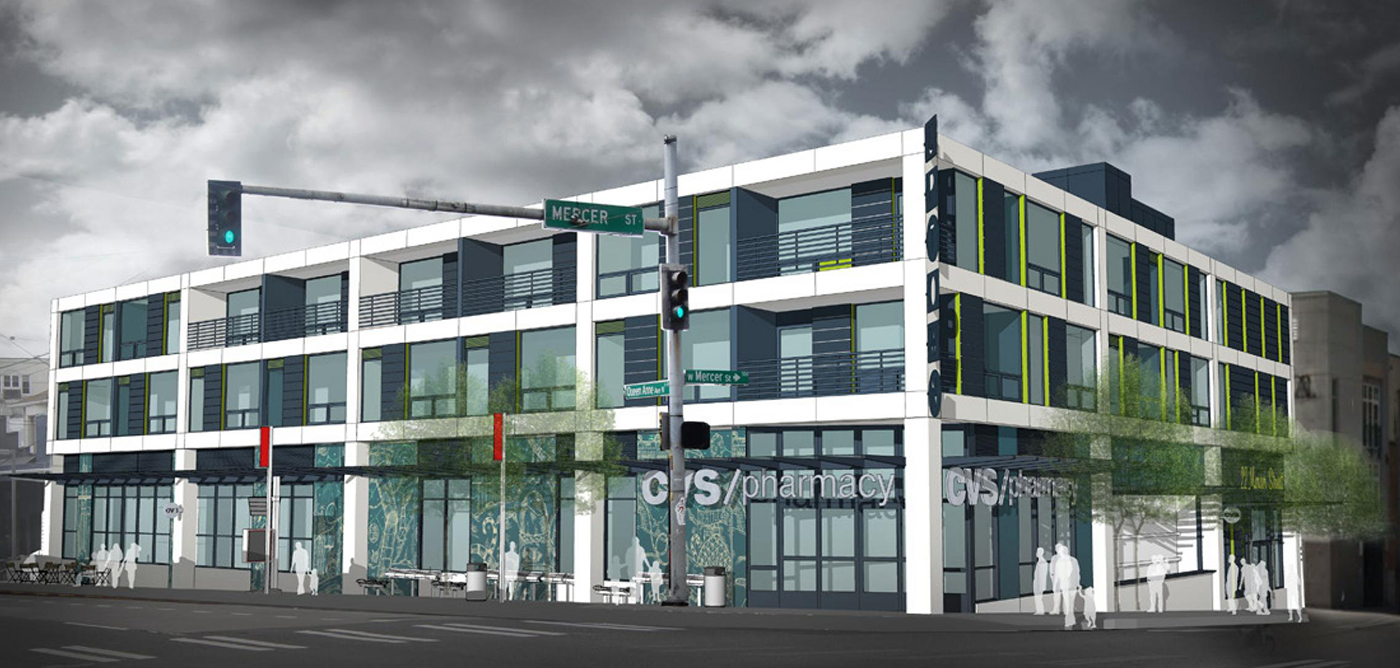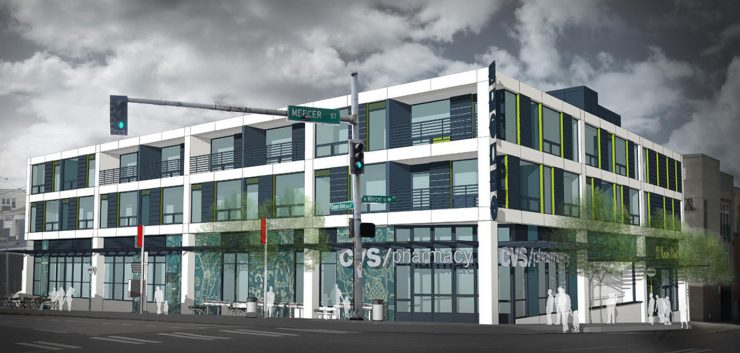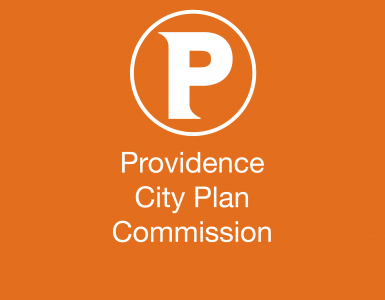
New CVS in Seattle’s Uptown neighborhood will feature two-levels of apartments and underground parking. – Rendering by Schemata Workshop
I’ve been hearing the same refrain lately when it comes to less than stellar development proposals in Providence, ‘it may not be great, but it is better than what is there now.’ The McDonald’s and Family Value in Olneyville is cited as better than the vacant lot that is there now. The LA Fitness on North Main is seen as better than the vacant building that is there now. And on it goes, there’s a defeatest attitude around here about having nice things.
As CVS starts to expand into Washington State, one Seattle neighborhood saw the company’s proposal and asked if they could build something better. Unlike CVS’s recent store back here at home in Edgewood, the company building the new store, The Velmeir Cos., said, ‘sure, let’s figure it out.’
The original proposal was for a one-story CVS at what the Seattle Daily Journal of Commerce describes as a high profile corner is Seattle’s Uptown neighborhood.
The DJC describes the new proposal:
The structure at 531 Queen Anne Ave. N. will have 16,000 square feet of retail space, mostly for the pharmacy, with 32 apartments above and 62 parking spaces underground. A small retail space along Mercer Street could be a food court.
The local neighborhood association, the Queen Anne Community Council, pushed the developer for a mixed-use structure after first being presented with the one-story single-use plan.
Geza de Gall, vice president of Pacific Northwest real estate for Velmeir
“It was pretty natural for (the project) to evolve to its present state,” [Geza] de Gall [vice president of Pacific Northwest real estate for Velmeir] said. “The community played a large part in helping guide us down that path.”
So different than the way the CVS in Edgewood played out.
Marty Kaplan, an architect and chair of Queen Anne Community Council’s Land Use Review Committee, said this project shows dedicated neighborhood groups can play a positive role. Too often, groups oppose a project but don’t give feedback on how to make it better.
Part of the problem in Providence is the late stage at which we see so many proposals and the City so often shrugging their shoulders and saying, ‘yeah but, economic development…’ Look at how much more economic development Seattle got by working collaboratively with community groups and the developer.
Another problem in Providence though is bizarre elitism, heaven forbid a CVS come into the neighborhood, we’d rather have a bespoke organic cafe that no one will ever go to… In the Olneyville case, I’m not opposed to the prospective tenants, I’d probably even go to the Family Dollar on occassion, it is the form that is a mess. Build to the street, put some badly needed housing on top, situate the parking so it can be built on later if conditions change (even less driving, more density needed) and the Olneyville project looks great.
This project started as a generic drug store you could find anywhere in the country, but after months of collaboration it now reflects the architectural style of the neighborhood and uses the maximum density allowed on a site that is just steps from a busy RapidRide stop.
Providence is not Seattle of course, conditions in each city are very different, but we’re not in a position where we have no reason to believe that better than nothing is the best that we can do.





Couldn’t agree more. We have to live with these physical envelopes for a long time, but all of the focus is always on the use which may not persist.
I once met with the City of Chicago’s architect who worked out of their sustainability office (although I am not sure it was called that when I met with her) and she told me that every time the city committed to upgrading the landscaping on a street–new lighting and street trees and planters, within a week a so of that information being actually written down somewhere (work order or what have you) they would have Starbucks knocking on their door about putting in an store. She said that the economic development followed the good urban street “clean up,” not the other way around. And I didn’t have any reason to doubt her.
Think about how good design and development begets more good design and development, and bad design and development just makes more of the same. If you don’t hold developers feet to the fire, there is no incentive for them to take the extra time and effort to make it a quality project. Why would they, if they can just scrape up the bare minimum and Providence’s inferiority complex will still reward them for that.
Providence deserves so much better than it gets, from its politicians and its developers.
Developers constantly call Providence’s bluff by insinuating they will move their project outside city limits if they are given any push back and Providence folds. And PVD ends up with really crappy development which holds other development from growing in an organic way. Developments that are “phases” end up dropping the cool parts of the phase because there’s nothing to stop them from promising with one hand, and taking away with the other.
The people of Olneyville may very well be clamoring for a McDonalds and a Family Dollar (even though the latter is going bankrupt) but it doesn’t have to be such a bad site plan that it would discourage any more projects or potential expansion.
Some folks would cry “when you tell poor neighborhoods what they HAVE to have, you are a gentrifier” but I would say that when you tell poor neighborhoods that they aren’t worth decent architecture, mixed used projects and a foundation for growth, you’re far worse than a gentrifier–you’re someone who is ok with giving the poor less than what you’d afford to more monied neighborhoods–kind of like that apartment in New York with mixed income units, but the low income inhabitants have to use the back door, rather than the plush front lobby.
Jef it’s great that you posted this.
Also in Providence there’s little tolerance to allow a development to use what are not considered “appropriate” materials (often more expensive). Seattle doesn’t require that windows must be set a minimum of 3-inches back for the surface of the facade and there’s no requirement that limits or restricts the use of metal or other “alternative” materials for exterior cladding.
I’m not suggesting that buildings should be clad in vinyl, but in Seattle they’re not so fussy about what builders can use. Projects there usually are beautifully designed, though not necessarily “traditional” as is often required in Providence because of “standards.”
Seattle encourages new construction through its land-use regulations and less restrictive requirements. In comparison, how has Providence’s standards been working out?
Not to take away from the point of Mothra’s post, but Family Dollar isn’t going bankrupt. It was struggling and shutting stores (as are many retailers). But it was not going bankrupt, and just recently agreed to be bought out by Dollar Tree.
Nifty piece, Jef. We’re surrounded by buildings from days past when people cared.
But nobody looks back: we get that awful hotel design from the Proccianti Group. The condo mess along Canal St that didn’t sell and is now rented to J&W. The not great design for the Power House residence (was anyone looking at the power plant’s great windows?).
Fortunately there is some community push back… On the design for Gilbane’s Thayer St. Apartments. The proposed tear down and new building at 44 Hospital St. In the Jewelry District.
Many of the property developers in Rhode island still have the same mindset than they did between the 50s-70s. The state as a whole is stuck in the past and refuses progress and change. Also when it comes to property development in RI, even the sight of a building proposal makes people overly happy to the point that they would be very upset if the proposal was rejected. Desperation causes the mind to not analyze because sometimes a mediocre idea is better than nothing. Desperation lowers standards.
People need to think about the full costs. It’s not just aesthetics, or even quality of life. The money doesn’t even add up on these projects.
I want to announce that the RI Sierra Club has decided that a parking tax with a give back on property taxes is one of our main transportation pushes this year. It may involve state approval, but given the need across the state to restore towns and cities while preserving farmland and wildlife, we think it’s worth it. I hope folks will help us make that push, starting in Providence.
Maybe then we can move beyond the strip malls.
Maybe we should all follow CVS to Seattle.
First I’d like for the city to do something about the superman building that is still sitting empty.
I would kill for an affordable, pet friendly (5 cats does make it easy) apartment to rent downtown!
I would live to see the south side near the Cranston like and jwu HS gets an improvement (we can start with better stops for ripta, the kind that have benches!)
The problem as I see it- as an outsider who moved into RI- is lack of vision. The people at city hall and the state house don’t have a vision for the state and it’s city. Once you have a well thought vision it’s much easier to grow and develop.
Does=doesn’t make it…
Sorry should have proof read my comment.
@Maya: The problems are not lack of vision, but poor execution, maintenance and service.
I don’t know, I think lack of vision in our leadership at all levels is a real problem. People need to get out more and see what else is happening in the world. And there is too much credence given to the naysayers who insist we cannot, should not, and will not ever have anything nice.
I’ll add that at least in Providence, the CVS I’ve seen gernally have some landscaping, greenery or trees on their site, but on Mineral Spring in North Providence, the vast CVS lot has almost nothing. (Think of the runoff!) I think the reason is that NP didn’t really ask them to do anything so they didn’t. CVS will improve their design if told to, but won’t if they don’t have to, an argument for strong local community input thru neighborhood associations, town planners etc.
I also think lack of vision is a big part of the problem. Without clear goals folks believe in and understand, decisions are haphazard and made under duress and uncertainty.
Barry – that Mineral Spring CVS was originally built as an Almacs, hence the huge lot. After they went belly up, it was subdivided into CVS, the party store and a Papa Ginos if I remember correctly. It hasn’t been fully occupied since Almacs left.
So next post (newest post) up lists two new parking lot sights on Harris Avenue. There’s certainly better things we can do with Harris than parking.
http://transportprovidence.blogspot.com/2013/03/harris-avenue-next-greenway.html
and
http://pbn.com/Greenway-seen-as-link-between-downtown-West-Side,92136?print=1
Certainly that’s not a “better than nothing” development. . . :-/
Opposition to the autocentric CVS design in Edgewood (Cranston) was grassroots, very vocal and well organized, but CVS got more or less what they wanted in the end. Likewise in Providence, several prominent neighborhood groups came out to oppose the sprawling design of the McDonald’s/Family Dollar lot but to no avail. There are many other examples besides.
So what is going on here? We seem to have an often visionary but politically very weak culture of urbanism. Is power too entrenched here, or is the opposition to this kind of development too fragmentary?
Because it doesn’t really matter what the people want; it has to matter what City Hall, Zoning and the City Plan Commission want (or are told to vote for.) Because developers don’t give a rat’s ass about “the people.” They just have to answer to those in charge of granting permits and variances.
It hasn’t changed all that much in the last 10+ years–those in charge want the easy way, the fast money way, the path of least resistance. And the developers are more than happy to comply.
Cities and towns with leadership who push back, who say “oh come on, you can do better than this,” with both their regulations and their language in face to face meetings, who encourage the boards of zoning and planning to grow a set are the ones that end up with better projects from the beginning, rather than having neighborhood groups constantly bring appeals and suits in order to get Providence just half way to decent development.
I have said in the past that something is better than nothing because after my 40 years of operating the business directly across the street from this location, I’ve seen Olneyville idle for far too long and it needs a catalyst to help break through. Will this project guarantee that?… I’m not sure… but it worked out well at University Heights on the East Side and there’s no reason that this development couldn’t spur more interest in Olneyville in the future.
For 8 years, we’ve been staring at this vacant lot (someone referred it to Olneyville’s missing tooth) and if any of you were involved in the Urban Land Institute Project in Olneyville a few years ago as I was, you would have learned from these experts as I did that the biggest problem for a neighborhood, both business and commercial, is the negative image abandoned properties and vacant lots give. A developer buys property and can’t always pick and choose what businesses might want to lease it in this failing economy. And, if the only business that comes forward needs certain designs to make it sustainable (the setback), who are they, or we, to discourage a taxpaying and job creating project that fits the demographics of an area that has many current setback storefronts already? And keep in mind, they haven’t asked for tax breaks or taxpayer funded loans. The brick building across the street that is set right to the sidewalk was vacant for about 15 years after it was built until Eblens leased only half of it. Ask them what they’re biggest problem is…and they will tell you it’s a lack of accessible parking.
This article references CVS…on 2 separate occasions, I met with the Senior Vice President of Real Estate for CVS/Caremark Bob Marcello at this site about 5 years ago and asked him to consider this for a location…unfortunately, they chose not to build here.
A lot of people seem to take a lot of interest in this matter behind a keyboard, but not enough to go and speak in person at these public meetings…and the last meeting 2 weeks ago where this project was approved by the board 5-0, no one testified in opposition.
Would a ‘set back’ McDonald’s and Dollar store be my first choice for this parcel?…no. If I could choose, I would want a Capitol Grille and a Starbucks…both set right to the street with parking in the rear…but that didn’t happen. This IS better than nothing because they’re the only businesses that have approached the developer and they’re going to invest over $2 million in Olneyville when no one else has.
Greg’s comments do show how our “what should be built and where” talk needs to become part of a larger discussion about economic power. The problem is that the amount of walkable retail that the car-free population of Olneyville can afford to support is pretty much what you see in place right now. The people most likely to spend enough to support any new business in Olneyville are the people already passing through every day, in their cars.
Double the minimum wage and some of those families in Olneyville will buy a car and shop elsewhere, but some of that cash will stimulate the kind of growth we like, right in the neighborhood.
I’m sorry but I don’t think that the razing of 13 mill buildings for a 13 acre shaws (where are they now?) shopping plaza was the catalyst that Olneyville needed back during the Eagle Square vs Felco. As much as I’d love to be be able to buy into the myth that empty = bad and full (regardless of what it is) = good, I simply cannot.
A catalyst is a reason to go somewhere. And if you cater to the lowest common denominator (Dollar Tree and McDonalds) the people who go there are the people who simply can’t go anywhere else. That probably sounds pretty snotty but that is the truth. If you want a place to improve, to be safer, to have more options for residents AND visitors, you have to give them those options.
And I don’t believe for one moment that the only retailers are the only retailers (perhaps in this case because I don’t know all the nuances but skeptical Mothra is skeptical) but in almost every other battle for Providence’s development soul, there have been OTHER interested parties who were run off because someone either in charge and/or with $$$ deep pockets wanted their own plan there.
The city needs to think about how the budget balances on these projects. Money coming in looks like a great idea, but if the costs of certain types of sprawly development are greater over time than what they bring us, then they’re not worth it.
http://www.ecori.org/smart-growth/2014/2/21/supersize-your-development.html
See also: